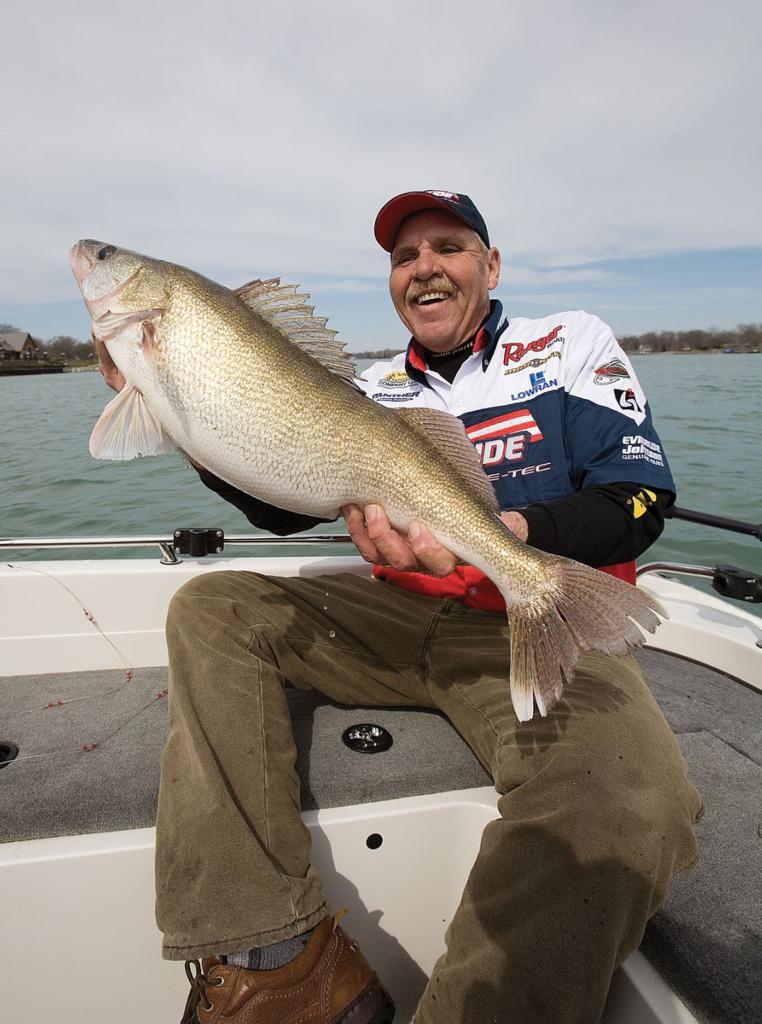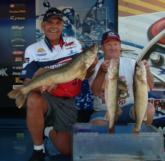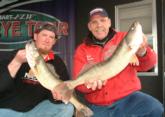Ask the Walleye Pro: Rick LaCourse

Q: I like to use shiners and tip-ups for walleyes on the ice. I don’t think I’m using the right line though. That, or I’m not tying the right knot. Anyway, I’ve lost too many fish over the past few years so I’m finally changing my ways. What kind of presentation (leaders and all) would you use for tip-up walleyes? Please be as specific as possible with everything. I typically use 3-inch shiners.
-Nick L., Nisswa, Minn.
A: My first question to you would be, “Where in the set-up are you breaking off?” My preferred set -up is pretty basic, I spool up with 30-pound Power Pro as my main line. Next, I use a No. 10 barrel swivel with 24 inches of 8-pound Berkley Vanish line. I like to use either a single hook or a small treble hook and attach them to my leader with a snell knot. Depending on the mood of the fish, I’ll tail hook my minnows between 2 inches to 4 inches in length and change them often to assure good action. Like I said, this is a very basic rig and has always worked best for me.
Q: I just read a short article on engine-mounted trolling motors. What percentage of FLW walleye pros use these new trolling motors? Do you use one? I read the advantages are precision steering with the wheel and speed control. When you steer with the wheel, does the whole main engine move or just the trolling motor? This is very intriguing. Tell me what you know. Would you recommend a weekend angler getting an EM on his 18-foot boat?
-GoBlue, UP Mich.
A: Minn Kota’s engine-mounted trolling motors are a great tool for anyone who takes their fishing seriously, from the weekend angler with an 18-foot boat to the seasoned tournament pro with a 21-foot boat. The EM trolling motors mount right to the cavitation plate of the big engine and steering is done with the big motor, not by the EM individually.
This allows the angler to have more control when steering. The weight of the big engine does not allow the EM to move, unless the angler chooses to change direction with the big motor’s controls. This feature comes in handy when you’re by yourself in the boat and trying to land a fish.
 While other transom-mount trolling motors have their place in someone else’s style of fishing, like someone who likes to backtroll for instance, the EM works with my style of fishing best.
While other transom-mount trolling motors have their place in someone else’s style of fishing, like someone who likes to backtroll for instance, the EM works with my style of fishing best.
On calm days, I can troll quietly in shallow water or put it in reverse in heavy seas when I want to slow the boat down without having to use drift socks. I use the 36-volt MK101 EM, which gives me enough power to troll all day long at varying speeds. It’s powerful enough to move a Ranger 620 or 621 at an average of 5 mph if needed, but its best performance characteristics are for the reasons I stated above. Figure out what your style of fishing is, and if the EM fits your needs, then by all means I highly recommend it.
Q: Why do pros recommend hooking leeches in the middle of the body when slip-bobber fishing? I think this is stupid. I think the leech should be hooked just below the sucker for all presentations. This gives the leech the best and most natural action. I just went to a Gander Mountain seminar and the pro insisted on hooking it in the middle. I think this is baloney. Some pro. What are your thoughts?
-Ron, Shakopee, Minn.
A: As in all things in life, what works for some people may not work for everyone. This is one of those cases. Does this make that pro’s suggestion any less plausible? No. Just different. I like to hook the leech just under the sucker also, but I’m going to have to try one in the middle sometime just to see what happens.
I have seen times when I have had a lot of short strikes, and the different action that rigging a leech in the middle would produce just might be the ticket to putting a limit in the boat one day. You should see some of the crazy stuff my wife comes up with when we are fishing. She’s so stubborn and will keep trying different things, even when I tell her what she SHOULD be doing. Sometimes she hits a homerun and says, “See? I told you so!” Sometimes I get to hear what every husband loves to hear his wife say: “Yes dear, you were right and I was wrong.” I think she would rather eat live night crawlers than to have to say those words.
A saying that any hardcore angler will tell you is this, “The day I stop learning and trying new things is the day I quit fishing.” So, the next time you’re slip-bobbering on your favorite spot, remember what that pro said. If it doesn’t work, then go back to using what works best for you. Just remember that until you try it, you’ll never know how it will work for you.
Q: What is your favorite spinner rig? Do you use a single-hook harness or multiple-hook harnesses? What is your favorite blade color? Do you use colored hooks? How long of night crawlers do you prefer?
-Chuck Netter, Marinette, Wis.
 A: That’s a great question Chuck. We could write volumes on this subject and debate them for hours. All winter long you can catch me sitting at the table making spinners for my up coming fishing season. If I’m fishing inland waters I use 10-pound Trilene XT with two No. 6 red Gamakatsu hooks. I also use small No. 3 beads on these. I use two different rigs when fishing open water like Lake Erie or Green Bay. If I’m fishing suspended fish and not touching the bottom, I’ll use 17-pound Trilene XT with a No. 2 red Gamakatsu in the front with a No.6 treble hook on the back with No. 6 beads. When I’m fishing close to the bottom, I’ll use two No. 2 hooks instead of a treble to help prevent hanging up on the bottom or picking up zebra mussels.
A: That’s a great question Chuck. We could write volumes on this subject and debate them for hours. All winter long you can catch me sitting at the table making spinners for my up coming fishing season. If I’m fishing inland waters I use 10-pound Trilene XT with two No. 6 red Gamakatsu hooks. I also use small No. 3 beads on these. I use two different rigs when fishing open water like Lake Erie or Green Bay. If I’m fishing suspended fish and not touching the bottom, I’ll use 17-pound Trilene XT with a No. 2 red Gamakatsu in the front with a No.6 treble hook on the back with No. 6 beads. When I’m fishing close to the bottom, I’ll use two No. 2 hooks instead of a treble to help prevent hanging up on the bottom or picking up zebra mussels.
There are times that I have used single hook rigs but 95 percent of the time I prefer my two-hook harness. I like about a 5-inch night crawler for my rigs, they seem to work the best and I find that I get a lot of short strikes with longer worms. Blade color changes with each body of water I fish. But if I had to choose it would be silver plated, gold plated then a copper in that order. All my blades are hammered, and make sure you have both Colorado and Indiana-style blades. Because of the difference in vibration the two blades give off, you’ll find that the fish will prefer one or the other on any given day.
Rick LaCourse is a veteran walleye angler who has fished the Wal-Mart FLW Walleye Tour, Professional Walleye Trail and Master’s Walleye Circuit. The Port Clinton, Ohio, resident won the 1997 PWT Championship and finished in fourth place at the 2004 FLW Walleye Tour Championship. LaCourse, who has earned over $114,000 in FLW Outdoors events alone, competes against his wife, Julia Davis, who also fishes as a pro on the FLW Walleye Tour. LaCourse’s sponsors include Ranger Boats, Evinrude, Minn Kota, Lowrance, Gemini Sport Marketing, Off Shore Tackle, Panther Marine Products, Dixie Marine and Clamps, Inc.